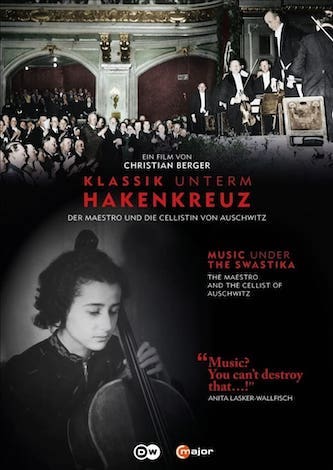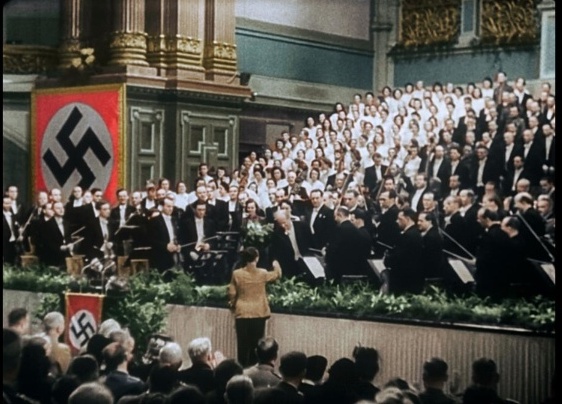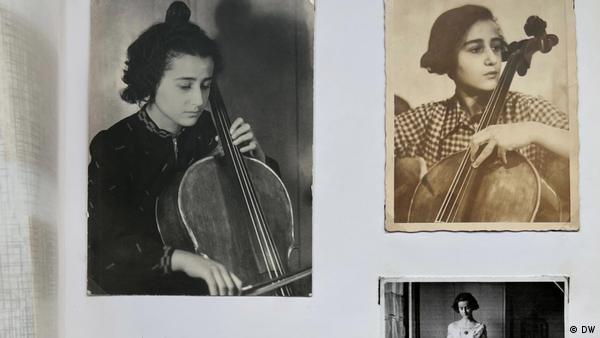Music Documentary Review: “Music Under the Swastika” — Uncomfortably Timely
By Jonathan Blumhofer
Much has already been written, said, and filmed about Nazi appropriation of Germany’s cultural heritage. So it’s to director Christian Berger’s credit that he’s managed to illuminate the maddening ironies and inconsistencies of the Third Reich’s cultural policies so clearly and cogently.
Music Under the Swastika — The Maestro and the Cellist of Auschwitz, directed by Christian Berger. Go to the link to view this film.
 “Hate is a poison. And, in the end, you only poison yourself.” So noted Anita Lasker-Wallfisch from the dais of the Deutscher Bundestag in May 2018.
“Hate is a poison. And, in the end, you only poison yourself.” So noted Anita Lasker-Wallfisch from the dais of the Deutscher Bundestag in May 2018.
She would know. Born into a German-Jewish family in Breslau (now Wroclaw, Poland) in 1925, Lasker-Wallfisch’s life was, like so many others, upended by the rise of Nazism and the implementation of the so-called Final Solution. Separated from her parents, then imprisoned with her sister for helping French POWs escape Germany, she found herself first in Auschwitz and then, just before the end of World War II, Bergen-Belsen.
Yet, thanks to various twists of fate, she survived (so did her sister, Renate). Central to Lasker-Wallfisch’s good fortune were her abilities as a cellist: when she arrived at Auschwitz she was inducted into the camp’s Women’s Orchestra by its conductor, Alma Rosé (niece of Gustav Mahler and daughter of the Vienna Philharmonic’s legendary concertmaster Arnold Rosé). Among other things, this spared her from work details and the gas chambers.
Lasker-Wallfisch’s harrowing and astonishing story stands at the center of Christian Berger’s absorbing new documentary Music Under the Swastika: The Maestro and the Cellist of Auschwitz. In it, the director places the cellist’s experiences within the larger context of the Nazi’s appropriation of Germany’s cultural heritage between 1933 and 1945.
About the latter, much has already been written, said, and filmed. So it’s to Berger’s credit that he’s managed to illuminate the maddening ironies and inconsistencies of the Third Reich’s cultural policies so clearly and cogently.
That pure, unadulterated Germanic culture was central to the Nazi concept of national identity is no secret. Never mind that such a thing could hardly be definitively characterized: the ideal was the central thing, as is explicitly underlined here with the inclusion of various speeches and broadcasts on the subject by Adolf Hitler, Josef Goebbels, and others. That even those who didn’t toe the party line were in broad agreement with the sentiment is embodied in the story of the film’s other protagonist, Wilhelm Furtwängler.
Music director of the Berlin Philharmonic Orchestra when Hitler was appointed chancellor in 1933, Furtwängler and his ensemble were the Reich’s artistic crown jewels. They were also among the regime’s most powerful propaganda instruments: at home, a tool for reinforcing at the highest level approved, German musical greatness. Abroad, too, Furtwängler and the Philharmonic were a comforting reminder of how, despite occasional reports to the contrary, the Nazi government supposedly stood for consistency, familiarity, and stability.
Though politically conservative by temperament and upbringing, Furtwängler was no fan of Hitler’s and he bristled at being told what to conduct and who might play in his orchestra. Even so, he was made to concede — after a single, infamous act of defiance in 1934 — that the Führer set cultural policy for the nation.
For most of the next 11 years, Furtwängler continued in his post, insisting with a straight face that he was a “non-political artist” — all the while conducting transcendent performances of Beethoven, Wagner, and Brahms for the concertgoing German public, workers in factories, wounded soldiers, and Nazi brass (once, notoriously, he led Beethoven’s Ninth to mark Hitler’s birthday). Unsurprisingly, many of these performances were taped and broadcast for political and propaganda purposes.
Justifiably, Furtwängler gets hammered in Music Under the Swastika for his choice to remain in Germany and continue practicing his craft. That, during the war years, he seemed to be doing so at an even higher level than his extraordinary usual doesn’t escape notice: conductor Christian Thielemann, himself no stranger to the occasional political controversy, sounds almost gleeful discussing the Hitler Birthday Concert.
At the other end of the spectrum is British journalist Norman Lebrecht. He doesn’t mince words: “We have to have a moral line that tells us if something is right or wrong,” Lebrecht offers at one point. “If you’re not going to be thrown into a concentration camp [for refusing to conduct for Hitler], why are you conducting?”

A scene from Music Under the Swastika — The Maestro and the Cellist of Auschwitz.
That’s a fair query, though it smacks a bit of armchair moralizing and overlooks the complexity of Furtwängler’s larger situation, which, in Lebrecht’s defense, is something the film doesn’t fully delve into either (though among its talking heads it counts two of the conductor’s stepchildren). In fact, Furtwängler’s enemies were real and dangerous: in one telling, his 1945 escape to Switzerland was prompted by Albert Speer’s warning that his arrest and execution by the Gestapo were imminent.
Besides, the answer is painfully simple: Furtwängler’s quasi-religious devotion to his art fundamentally warped his moral judgment. In this, at least, he wasn’t alone. Decades of jingoistic musical and cultural indoctrination had done its work on him and countless other Germans.
This fact, which Berger roots in the residue of 19th-century nationalism and the noxious antisemitism of Richard Wagner, made the job Hitler and Goebbels had before them exponentially easier. Indeed, it’s telling that so many of the individuals who populate this narrative weren’t true villains — yet they all quickly grasped the cloak of “culture” to later defend or excuse their actions.
A few, like Winifred Wagner, were true believers. But many, maybe most, were either opportunists or people simply going along because they felt they had no other option than to do as they were told. Some of them were giants, some were small.
Among the former, Richard Strauss surely had options. Germany’s greatest living composer, Strauss viewed the new regime with disdain, as became apparent when a letter of his complaining about their anti-Jewish policies was intercepted by the Gestapo. But that didn’t stop him from lending his prestige to the Reichsmusikkammer, fulfilling high-profile government commissions, approving of the Nazis’ pro-German musical policies, and, at one point, dedicating a song (“Veilchen”) to Goebbels.

A scene from Music Under the Swastika — The Maestro and the Cellist of Auschwitz,
Others, like Werner Ekg (who’s represented here by a snippet from his pompous hymn “Mein Vaterland” — think the musical equivalent of one of Arno Brecker’s Führer-approved nudes), were less privileged. Not all joined the Nazi party. Strauss and Furtwängler didn’t; Furtwängler’s successor in Berlin, Herbert von Karajan, did — twice. But nearly all made some sort of accommodation with the regime.
Taken together, it’s sordid, depressing, and gives fresh understanding to Hannah Arendt’s famous observation from Eichmann in Jerusalem: “He had no motives at all,” she wrote of the Nazi war criminal in 1961. “He merely … never realized what he was doing… It was sheer thoughtlessness … that predisposed [Eichmann] to become one of the greatest criminals of that period.”
Even more unsettling in Music Under the Swastika are the glimpses of humanity Berger locates, through music, in the perpetrators of the chaos.
In Wagner’s descendants at Bayreuth, for instance, Hitler found “the family he never had,” as that town’s Wagner Museum director Sven Friedrich puts it. “It’s important to acknowledge this part of [him], this human dimension” that seemed to emerge only in that place, he argues. Similarly disturbing is Lasker-Wallfisch’s account of playing Schumann’s Träumerei for Josef Mengele (“I played it as quickly as possible”). “It’s interesting to note,” she says later, “that these people … were not uneducated.”
Nor were they uncultured. And yet, of course, neither education nor culture stayed irrational hatred, unfettered violence, or senseless destruction.
Then again, education and culture are a double-edged sword: they preserved Lasker-Wallfisch’s life. Liberated by British troops in April 1945, she ultimately settled in London, raised a family (her grandson, baritone Simon Wallfisch, also has a starring role in the documentary), and was a founding member of the English Chamber Orchestra. Now nearly 98, her dignity, wisdom, and humanity permeate this film.
Whether or not one agrees with the cellist’s final assessments of her more famous contemporaries (which I won’t spoil by revealing here), Lasker-Wallfisch’s lucidity, generosity, and decency provide a striking counterpoint to Furtwängler’s head-in-the-sand naïveté, Strauss’s egocentricity, and the vitriolic outbursts of Hitler and Goebbels.
Indeed, Music Under the Swastika’s most stirring moment is the above-mentioned scene of Lasker-Wallfisch addressing the German parliament from the well of the Reichstag — the very spot where, a lifetime ago, Hitler alternately thrilled and terrified his audiences. It’s a subtle, but knowing, climax to a film whose respect for its main character is affecting but never cloying.
While we haven’t got a full accounting here of music under the Third Reich (jazz and popular music get short shrift, and one hopes Berger might someday turn his attention to the great anti-Nazi composer Karl Amadeus Hartmann), the tale that’s told is grippingly paced. Berger’s filled out his narrative with plenty of period footage, nearly all of it colorized, and this lends his storytelling a refreshing immediacy.
Among the memorable clips are those of a beaming Furtwängler chatting backstage at Bayreuth with Hitler and snatches of newsreels that show Lasker-Wallfisch walking out of Bergen-Belsen (interviews she taped with the British after her liberation in 1945 feature heavily over the documentary’s first act). Alas, there are no extended recordings of her playing the cello, but numerous Furtwängler performances and an excerpt of him in rehearsal testify to his artistic standing.
The director has also assembled an A-list lineup of commentators. If Kathrin and Thomas Ackermann haven’t got much of critical substance to add to the discussion of their stepfather, it’s still fascinating to get a flesh-and-blood perspective on this near-mythical podium figure from those who knew Furtwängler up close.
Among music writers and practitioners, Lebrecht’s righteous anger at Furtwängler and a German musical establishment that never fully made amends for its sins is balanced by Daniel Barenboim’s nuanced appreciation of his mentor and Thielemann’s clear admiration of him. Academic contributors, nearly all of whom are German, tackle the subject matter head-on: all have clearly grappled seriously with the events of the recent past.
The last fact is particularly welcome given that Music Under the Swastika feels uncomfortably timely, especially considering recent flurries of antisemitism and efforts at culture war mongering in this country. Even without going to the extremes of Auschwitz and Bergen-Belsen, the dangers of unchecked hate perpetrated under the shield of presumed cultural supremacy are real. And the road to ultimate destruction is lined by spiritual apathy, intellectual carelessness, and moral equivalency.
“That such remoteness from reality and such thoughtlessness,” Arendt wrote of Eichmann’s mindset, “can wreak more havoc than all the evil instincts taken together which, perhaps, are inherent in man — that was, in fact, the lesson one could learn in Jerusalem.” It’s a lesson that can be learned anew today (albeit with a glimmer of hope at the end) from the remarkable story of Anita Lasker-Wallfisch in Music Under the Swastika.
Jonathan Blumhofer is a composer and violist who has been active in the greater Boston area since 2004. His music has received numerous awards and been performed by various ensembles, including the American Composers Orchestra, Kiev Philharmonic, Camerata Chicago, Xanthos Ensemble, and Juventas New Music Group. Since receiving his doctorate from Boston University in 2010, Jon has taught at Clark University, Worcester Polytechnic Institute, and online for the University of Phoenix, in addition to writing music criticism for the Worcester Telegram & Gazette.
Tagged: Anita Lasker-Wallfisch, Christian Berger, Music Under the Swastika

“As [Furtwangler’s] friend the conductor Bruno Walter wrote to him, ‘your art was used as a conspicuously effective means of propaganda for the Regime of the Devil.'”
https://www.bostonglobe.com/2022/04/15/opinion/is-boston-marathons-canceling-russians-denazification-30/
… and, as I found, Furtwangler “was known to have helped Jews as well as ‘anyone who asked him for help during the Third Reich,’ according to his biographer, Sam H. Shirakawa.” It’s complicated.